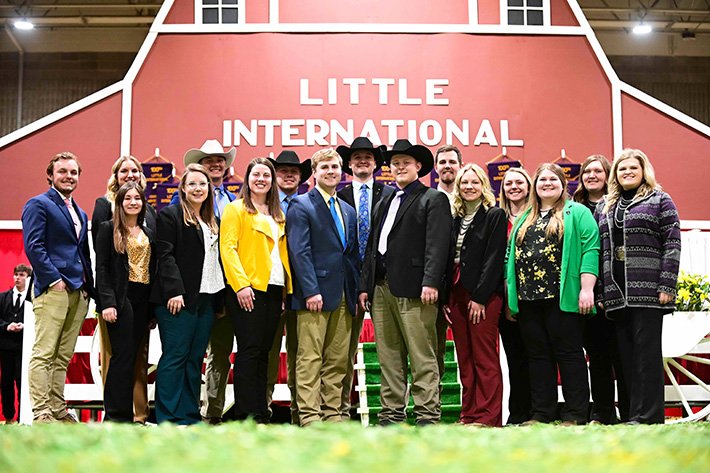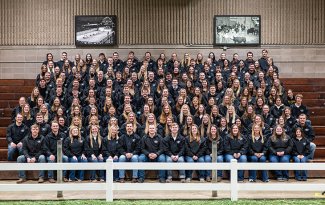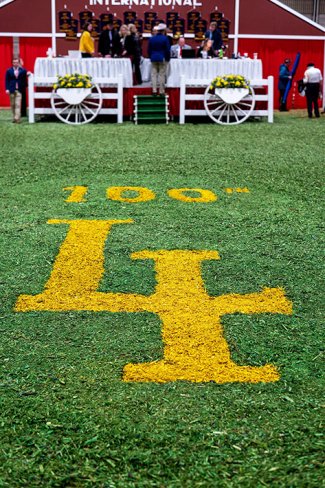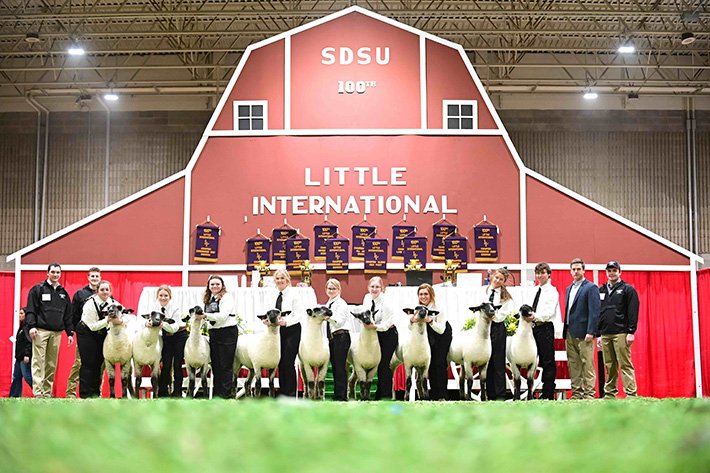
For 100 years, South Dakota State University’s Little International has been “Built on Tradition, Powered by a Vision,” providing multiple generations of students with a rich tradition of legacy and learning. In addition to being the largest two-day, student-run livestock exhibition in the nation, Little “I” is one of SDSU’s most beloved traditions.

To commemorate the 100th year, Little “I” staff members worked with the South Dakota Agricultural Heritage Museum and SDSU Archives to document the exhibition’s evolution.
The early years
SDSU’s Little “I” began on campus in 1921 and was modeled and named after the International Livestock Show, held during the 20th century in Chicago, Illinois. The college’s Agricultural Club sought to create a smaller-scale version of the event. The first SDSU Little International show was held in the SDSU Stock Judging Pavilion, the building which eventually became today’s South Dakota Agricultural Heritage Museum. A staff of fewer than 15 people from the college’s Agricultural Club helped make the first event happen. In comparison, the 100th Little “I” staff was made up of 164 student-volunteers from all the academic colleges across SDSU’s campus. The current staff was divided into 50 committees, playing an essential part in the success of Little “I.”
There have only been four years where SDSU’s Little International was canceled. The first three cancellations took place near the beginning of Little International’s history. In 1926, the event was canceled due to the scarlet fever epidemic, and in 1944 and 1945, it was canceled due to World War II. After a few years of recovery following the war-related cancellations, Little “I” leaders decided the show needed to be moved. In 1942, SDSU’s Little “I” relocated to the SDSU Intramural Building, now called “The Barn.” The show moved again in 1977 to where it is held today, the SDSU Animal Science Arena.
The fourth cancellation was in 2020, when the COVID-19 pandemic led to the cancellation of the 97th Little “I” just weeks before it was scheduled to take place. In 2021, COVID-19 protocols and safety were still a significant consideration. All students and spectators at the 98th Little “I” were asked to wear a mask, and all FFA and 4-H contests were offered online.
About the show
Throughout its history, Little “I” has allowed students to gain skills in showmanship, animal husbandry and agricultural-based career paths. Students can show anything from horses or dairy to swine, goats or beef. However, the event isn’t all about the livestock show. Students can test their knowledge through wool judging, meat judging, dairy product creation, machinery sales and more. Many students have learned how to be leaders, problem-solvers and team players by volunteering as part of the Little “I” staff.
Little “I” continues to evolve and grow based on staff and participant interests, while maintaining the most meaningful traditions.
Red barn

One tradition that stands out is the famous SDSU Little International red barn. The silhouette of the red barn used as a stage backdrop began with the move to the second home of Little “I,” The Barn. Two barn silhouettes were made and used over the 25 years that the event happened in The Barn. After moving to the Animal Science Arena, three other barn backdrops served their time in the rotation. The first barn is no longer around, the second one continues to hang in the Animal Science Arena all year long, and the current one is stored and erected at the beginning of each Little “I” week. The barn is put up the Monday before the show and comes down the Sunday after the event concludes. Before it is put away, each manager signs the back of the barn to “leave their mark” on history.
Green chips
One of the longest-lived traditions of the SDSU Little “I” is the use of green wood chips in the show ring. This, like the name, came straight from the International Livestock Show. It was said that livestock looked their best in their natural environment—grass. Dying the chips green to look like grass gives a similar effect. Tradition requires the current Little “I” manager and assistant manager to dye the chips.
Livestock show
Then: The first Little “I” was strictly a livestock show, and the students could select from beef or dairy cattle, sheep and horses to exhibit. The species were shown in a traditional livestock show. Cattle and hogs were divided into classes by breed, sex and age, and poultry was shown in classes solely based on breed.
Now: By comparison, at the 100th Little International, over 150 undergraduate students participated in the livestock shows, showing one of six species including beef or dairy cattle, sheep, horses, swine and goats. Unlike most livestock shows, the species are divided into two classes, experienced and novice, based on the showman’s level of prior experience. This allows students who may not have had a background in the livestock industry or a particular species to participate on an even playing field. The participants compete in both showmanship and fitting (grooming) contests. The Little “I” livestock competitions currently aren’t about the quality of the animal, but the students’ ability to prepare and exhibit the animal.
Career development events
Then: In the event's early years, the livestock shows were the focus of Little “I.” However, the former SDSU College of Home Economics held the Home Economics Exposition in conjunction with Little “I” and had its own competitions displayed at the event during the mid-century. Students in this college competed and provided clothing, food, and arts and crafts demonstrations. In 1962, the event's group wanted to promote agricultural knowledge and skills to high school students. FFA and 4-H members from South Dakota and Minnesota were invited to compete in the first-ever Little International FFA and 4-H contests. These contests were developed to allow high school members to gain experience for use in future judging contests. To help promote their goal, Little “I” staff members asked that after judging was completed, a model set of reasons be given for each class by the judge of that class. The judges were professors at SDSU and experts in their field. At this first event, judging contests for beef, swine and sheep were offered.
Now: At the 100th Little International, over 2,000 local FFA and 4-H students registered to participate in career development events. These students were planning to travel from Minnesota, Iowa and Wisconsin in addition to South Dakota schools. Students would have had the possibility to compete in Agronomy, Ag Product Sales, Dairy Cattle Judging, Farm Business Management, Floriculture, Livestock Judging, Horse Judging, Meats Judging, Milk Quality and Products, Natural Resources, Nursery Landscape, Poultry Judging, Range Identification, Vet Science and two new contests, Ag Mechanics and Machinery Sales. Unfortunately, the career development events were canceled due to a winter storm.
"Built on Tradition, Powered by a Vision" is a perfect testament to the incredible purpose and traditions formed throughout the first 100 years of Little International, and the hope that those traditions will continue to stay true for 100 more. Little International’s true purpose is to serve both high school and college students alike. The exposition provides students a fun and competitive opportunity to make new friendships, try new things and refine skills essential for lifelong success in the agricultural industry.

Republishing
You may republish SDSU News Center articles for free, online or in print. Questions? Contact us at sdsu.news@sdstate.edu or 605-688-6161.

